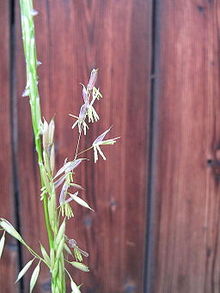Wild rice
![]()
This article describes the genus water rice (Zizania). For the morphological term, see water rice (plant morphology).
![]()
Wild rice is a redirect to this article. For other meanings, see Wild rice (disambiguation).
Water rice (Zizania) is a genus of plants within the sweet grass family (Poaceae). The four or so species are widespread in North America and East Asia. The plants often grow in stands along riverbanks, lakeshores and ponds. The fruits of some species are used like rice grains.
Cultivated forms of the species Zizania palustris are commercially available under the names wild rice, Indian rice or Canadian rice. The common name "wild rice" is not a botanical name. Notably, Zizania species are not wild forms of rice (Oryza sativa). The genus Zizania (water rice) should be distinguished from the genus Oryza (rice), even though both belong to the same tribus Oryzeae.
Description
Vegetative characteristics
Zizania species are annual or perennial herbaceous plants. They are aquatic and marsh plants (hydrophytes and helophytes). The hollow culms reach growth heights of between 1 and 3 metres.
The plants form both submerged and emersed leaves. The simple leaf blades bear no auricles and are 5 to 30 centimeters wide. The unfringed ligules are between 3 and 11 millimetres long.
Generative characteristics
Zizania species are monoecious and pre-female (proterogynous). The terminal, paniculate inflorescences are relatively large. All spikelets are unisexual. The spikelets with male, overhanging flowers are on the lower panicle branches and those with ascending, female flowers are on the upper panicle branches. The lemmas of the male flowers are acute, ungrenulate or short-bearded, and five-nerved; the bracteoles are three-nerved. The male flowers have six free stamens. The three- to five-nerved lemmas of the female flowers are awned and the awns are as long as or much longer than the lemmas. The bracteoles are keeled and two-veined. The glabrous ovaries bear two stigmas. The partial inflorescences do not bear glumes.
The 1 to 2 centimetre long, almost needle-shaped caryopses are initially green and turn dark brown to black when dry.

Fruits of Zizania palustris darkening on drying

Detail of an inflorescence with male flowers of Zizania aquatica
Systematics and distribution
The genus Zizania was established by Carl von Linné. The genus name Zizania is derived from the Greek word zizánion for "growing in water" and refers to the place of growth. The genus belongs to the tribus Oryzeae in the subfamily Ehrhartoideae within the family Poaceae.
The genus Zizania comprises four species:
- Zizania aquatica L. - annual, in North America
- Zizania latifolia (Griseb.) Turcz. ex Stapf, 'Manchurian water rice' - perennial, in East Asia
- Zizania palustris L. - annual, in North America
- Zizania texana Hitchc. - perennial, in North America
Zizania palustris has only been considered a separate species since the 1980s. Previously it was considered a variety of Zizania aquatica. The synonym Zizania aquatica var. angustifolia refers to this earlier classification.
The North American species are often grouped under the name wild rice. They are distributed as follows:
- Zizania aquatica inhabits the temperate eastern and southeastern United States along the Atlantic coast from the St. Lawrence River through Florida to Louisiana.
- Zizania palustris is much more widespread: in a boreal to temperate region of Canada and in the north and Midwest of the USA, from the Pacific coast to the Great Lakes region.
- Zizania texana is an endemic of a small region in Texas, on the San Marcos River.
Questions and Answers
Q: What is wild rice?
A: Wild rice is a type of grass that belongs to the genus Zizania. It is also known as Indian rice, Canada rice, and water oats.
Q: What can be harvested from wild rice?
A: The grain from wild rice can be harvested and eaten.
Q: Where is wild rice eaten?
A: Wild rice was historically eaten in both North America and China, but it is now more of a delicacy in North America. In China, the plant's stem is used as a vegetable.
Q: How many species of grasses form the genus Zizania?
A: Four species of grasses form the genus Zizania, which includes wild rice.
Q: What is the historical significance of wild rice?
A: Wild rice was an important food source for Native Americans and was also eaten by Chinese people.
Q: Why is wild rice no longer eaten in China?
A: In China, the stem of the wild rice plant is used as a vegetable instead of the grain.
Q: Is wild rice still widely consumed today?
A: While wild rice is now more of a delicacy in North America, it is still consumed and harvested for its grain.
Search within the encyclopedia